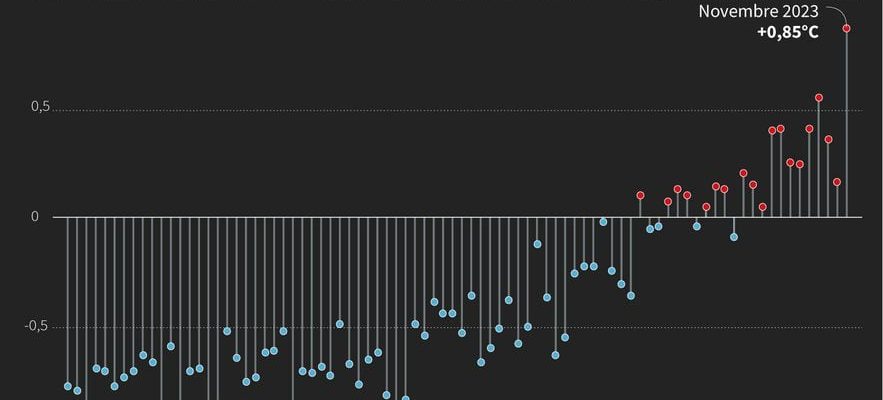It’s now official. The year 2023 will be the hottest in history after an “extraordinary” month of November which became the sixth consecutive month to break records, declared Wednesday, December 6, the European Copernicus service in the midst of climate negotiations at COP28 .
The past month, with an average of 14.22°C on the surface of the globe, exceeds the previous record of November 2020 by 0.32°C. November 2023 is also 1.75°C warmer than the average for a month of November for the period 1850-1900, which corresponds to the pre-industrial era.
“A wide margin”
The boreal autumn (September to November in the northern hemisphere) is thus the hottest in history, with 15.30°C, or “a wide margin” of 0.88°C above average.
“2023 now has six months and two record seasons. This extraordinary November, including two days with temperatures 2 degrees higher than pre-industrial times, means 2023 is the hottest year on record in history “said Samantha Burgess, deputy head of Copernicus’ climate change department (C3S), in a statement.
The hottest November ever measured
© / AFP
Since January, the average temperature has been the hottest ever measured over the first eleven months of the year: 1.46°C above the climate average for the period 1850-1900, and 0.13°C above of the first eleven months of 2016, the hottest year yet.
“As long as greenhouse gas concentrations continue to rise, we should not expect results different from those observed this year. Temperatures will continue to rise, as will the effects of heat waves and droughts,” warned Carlo Buontempo, director of C3S, quoted in the press release.
El Nino fuels the rise
The cyclical climatic phenomenon El Nino, over the Pacific, continues to fuel the rise in temperatures in 2023 but has, for the moment, not yet reached its peak. In November 2023, the ocean surface temperature is also the warmest for this time of year, 0.25°C higher than during the previous peak in November 2015. This new heat record adds to those already beaten every month since April.
The extent of the Arctic sea ice, in the north, recorded its 8th monthly minimum for November, 4% below average. In Antarctica, a second lowest level for the month of November was recorded, 9% below the average, Copernicus indicates.
Drought continued last month in several regions of the United States, Central and East Asia, and was particularly pronounced in South America. On the other hand, Europe was wetter, in the wake of storm Ciaran which caused significant rainfall.
